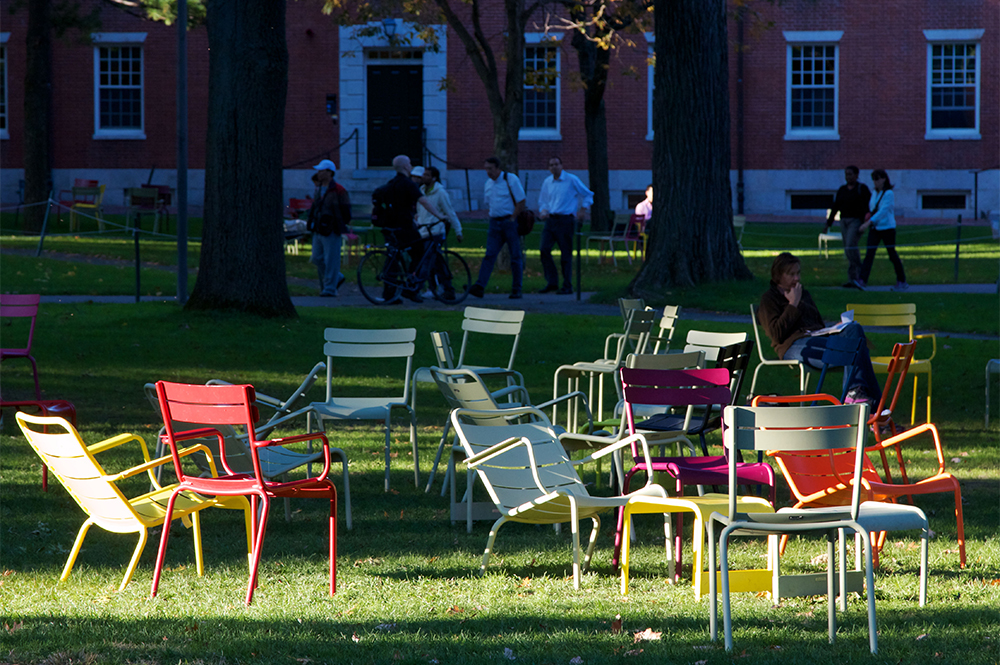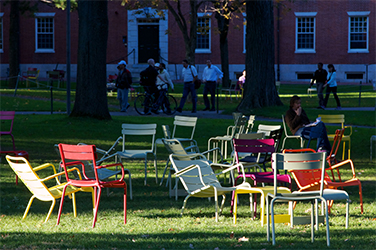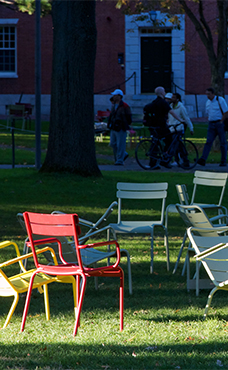- Free Article: No
- Contents Category: Commentary
- Custom Article Title: ‘Too busy to have time for us’: Reflections on Australian Studies at Harvard
- Review Article: Yes
- Article Title: ‘Too busy to have time for us’
- Article Subtitle: Reflections on Australian Studies at Harvard
- Online Only: No
- Custom Highlight Text:
In 1976, the Australian government signed an agreement with one of the leading universities in the world, Harvard, to fund a visiting professorial position in Australian Studies. Originally conceived by the government of Gough Whitlam, the gift of US$1 million was a token of Australian goodwill to the United States on the bicentennial celebration of the American Revolution. Its purpose was to promote increased awareness and understanding of Australia by supporting teaching, research, and publication.
- Article Hero Image (920px wide):

- Article Hero Image Caption: Colourful chairs in the sun in Harvard Yard, the old heart of Harvard University (photograph by Jannis Werner/Alamy)
- Alt Tag (Article Hero Image): Colourful chairs in the sun in Harvard Yard, the old heart of Harvard University (photograph by Jannis Werner/Alamy)
- Featured Image (400px * 250px):

- Alt Tag (Featured Image): '"Too busy to have time for us": Reflections on Australian Studies at Harvard' by Joan Beaumont
The Gough Whitlam and Malcolm Fraser Chair of Australian Studies, as it became known, was a striking bipartisan gesture of cultural diplomacy at a time when Australian Studies flourished across the nation. Its apostles claimed with an almost evangelical fervour that rigorous interdisciplinarity would create a new synthesis. Nearly half a century later, much in the world of Australian Studies, cultural diplomacy, and university education has changed, and it might be asked: what has the Harvard Chair achieved, and what might its future be?
The impact of cultural diplomacy is notoriously difficult to quantify, since one of its main aims is to change, for the better, the attitudes of foreign populations. Of one thing, however, we can be certain: the Harvard Chair has enriched the professional lives of those forty Australian men and women who have been fortunate enough to occupy it since 1978, usually for a year. Given Harvard’s expectations of intellectual excellence, the list of appointees has been illustrious.
One of the founding fathers of Australian history, Manning Clark was the first formal appointment under the agreement. Whitlam, recently retired from politics, himself followed in 1979. Almost all subsequent chairs were scholars (mostly male) with stellar academic reputations, mainly in the humanities and social sciences. Many have been historians and political scientists, the mix being leavened by the occasional artist, biologist, musician, and lawyer. Mick Dodson, the Aboriginal leader and 2009 Australian of the Year, was based in the famed Kennedy School of Government in 2011.
This disciplinary orientation was anticipated in the original agreement, where it was assumed that the humanities and social sciences would be inherently and more explicitly ‘Australian’ in their content. What, it was asked, was distinctively ‘Australian’ about engineering, digital technology, natural science, or medicine? (In fact, Australian science, for one, can offer distinctive perspectives on climate change and drought.)
Moreover, the Chair can only be appointed if a department at Harvard agrees to the nomination made by an Australian Committee. Some departments have been notably supportive; others, less so.
Former Chairs’ memories of the time they spent at Harvard are almost universally positive. Harvard became the jewel in the crown of the Australian Studies visiting professorships that sprang up across the globe from the 1980s on – among them, University College Dublin; the University of Tokyo; the Menzies Centre in London (now located in King’s College); the University of Copenhagen; and the BHP Billiton Chair in Australian Studies at Peking University, Beijing. Winning the Harvard Chair rapidly became an honour that adorned a professional CV.
Harvard, too, has always offered the opportunity to meet and work with some of the world’s best students and scholars. Research contacts can be extended beyond Cambridge through attending conferences at other academic institutions and think tanks. The benefits of this networking have often extended beyond the individual scholar. The value of collaborative research in the United States has lasted over the years, while local institutions have benefited from subsequent visits by American scholars.
For Australian academics jaded by the pragmatic approach of many domestic undergraduates (‘I just need the piece of paper’), Harvard students are a delight to teach: extraordinarily able, self-confident, sometimes even brighter than their teachers. As one former Chair recalled: ‘If I came into the US class and said the American President had been killed, who will save the US and be President … all the class would put up their hands instantly … and they would believe they could do it. In Australia no student would put up their hand but if you pressed the class really hard some might say “I can try. I will do my best?”.’
What of the impact of the Australian Studies Chair on the wider Harvard community? It is hard to tell. Harvard is a complex and exceptionally well-endowed university. In the Law School, alone, one former Chair counted at least twenty such visiting positions in one semester. Visibility for the Australian chair can be a problem. Harvard is ‘simply too busy to have time for us’. Chairs, then, need to be extroverts as well as stellar scholars (the two qualities are not always aligned).
Whatever its quality, teaching has a modest impact as cultural diplomacy. Harvard does not offer a formal Australian Studies program, as does the Edward A. Clark Centre for Australian and New Zealand Studies, University of Texas, Austin, or the University of Tokyo. Without a structured academic context, there is no progression for interested students. ‘Australian’ courses simply stand alone, competing with multiple others in a highly discerning student market. Over the years, enrolments in courses offered by Chair holders have ranged from the healthy to the very low – even zero. Possibly if the Chair were held for a longer period – as is the Canadian counterpart at Harvard – student numbers might build up through word of mouth.
The Widener Library (a towering temple of learning in the Harvard Yard funded by the mother of a young man who went down with the Titanic) holds an impressive collection of Australian titles. The original endowment specified that funds could be used to purchase publications on Australia and the Library maintains and enhances this collection, especially in the humanities and social sciences. But books need to be read, and the Widener has no data as to how often Australian titles have been borrowed.
Neither of the two major bookshops outside the Yard has (in 2022) an identifiable Australian section among their well-stocked shelves. That said, books with Australian content and/or by Australian authors might still be found in thematic sections. Both stores are willing to order Australian titles on request.
The demand for Australian content will probably remain low. It is no cultural cringe to ask why US students should want to study Australia – any more than why Australian students should want to study another relatively small middle power, such as Canada. Is Australia a problem that will repay significant intellectual investment by US students? Are Australia and the United States too similar socially to engage those students looking for exotic learning experiences? The healthy Study Abroad market of two decades or so ago has shrunk, and with this the interest in Australian Studies has also withered.
Moreover, the intellectual fashion for area studies has waned. From the 1990s scholars moved towards positioning Australia within wider transnational and comparative perspectives, including the imperial. Intellectually commendable though this might be, the distinctiveness of the Australian ‘core’ is arguably diluted. The pressure on Australian scholars to demonstrate ‘relevance’ to contemporary issues tends also to risk trivialisation in the eyes of more traditional Harvard academics.
None of this should be read as discounting the value of the Australian Studies Chair at Harvard. It has done many good things. The local Committee of Australian Studies, formed of faculty members across the University, is ably chaired by George Putnam Professor of Organismic and Evolutionary Biology, David Haig. On his astute watch, the Chair’s funding has been defended against potential predators and the reach of ‘the Chair’ has extended well beyond the teaching and research of the incumbents.
In 2011, the original agreement establishing the Chair was amended, allowing surplus funds to be used to support student research and to facilitate conferences and other cultural activities profiling Australia. In 2010, a conference on climate change was convened by then Chair, Alison Bashford. Including a suite of eminent scholar–colleagues, this meeting provided the opportunity for sixteen postgraduate students from Australia to pair with students selected competitively from Harvard’s Faculty of Arts and Social Sciences. A further eighteen Chinese postgraduate students were selected from the then China 9 Group.
In 2016, meanwhile, the Committee for Australian Studies took a leading role in developing an exhibition of contemporary Indigenous art. With backing from Australia’s Department of Foreign Affairs and Trade and the Australian Consulate-General, New York, the exhibition was curated by the Australian Studies Visiting Curator at the Harvard Art Museum, Stephen Gilchrist, of the Yamatji people of the Inggarda language group of Western Australia. Local collaborators included the esteemed Peabody Museum of Archaeology and Ethnology and the analytical laboratory of the Straus Center for Conservation and Technical Studies at the Harvard Art Museums. The latter conducted the first ever large-scale technical examination of traditional Indigenous bark paintings The exhibition catalogue was published by the Harvard Art Museums and distributed by Yale University Press.
Such exemplary cross-institutional collaboration should surely impress even those among Australia’s governing élite who view the humanities as an irrelevance and who expect international education and cultural diplomacy to be transactional and instrumental rather than having intrinsic merit.
Fortunately, the Harvard Chair is financially secure, the 1976 gift having grown via judicious investment. In biblical terms, the two talents have grown to considerably more than ten. In contrast, the Keith Cameron Chair in Dublin has died for lack of funding. Canberra was purportedly more interested in Asia. Efforts to find other donors – even if this meant renaming the Chair the ‘Go, Harvey, Go’ Norman Chair – failed. The pre-Covid appointment to Dublin will be the last. Likewise, the Distinguished Visiting Professorship in Australian Studies at the University of Copenhagen concluded in 2016 and funding was not renewed.
Perhaps the risk for the Harvard Chair lies elsewhere. Australian academic life is now very different from 1976. Increased class sizes; the demands of digitally enhanced teaching as well as face-to-face; the casualisation of much of the workforce; and the insistence that humanities and social sciences research should fit into a procrustean bed of ‘relevance’ and ‘national impact’: all these militate against excellence in scholarship as Harvard understands it. Rather than valuing the pursuit of research funding against difficult odds, Harvard sees the single-authored ‘Big Book’ as the benchmark.
Without being unduly pessimistic, we might ask if scholars beginning their academic careers today will have the same opportunities as their predecessors to build up the kind of publication portfolios that Harvard expects? The talent and the will are certainly there, but what about the time and the intellectual space? Big books take years to research and write. Australian research metrics rarely recognise this.
Perhaps, then, the Harvard Chair reminds us that these metrics generate serious distortions in academic practice. Let’s reinstate the book to the place it deserves in the pantheon of the humanities and social sciences and acknowledge the challenges of writing such important works.
In writing this article while visiting family in Cambridge, Massachusetts, I consulted the chair of the Australian Studies Committee at Harvard University, Professor David Haig, seventeen former incumbents of the Harvard chair, other Australian Studies colleagues, and the collections department of the Widener Library, Harvard. Quotations are unattributed for reasons of privacy, and the opinions expressed are my own.
This commentary is generously supported by the Judith Neilson Institute for Journalism and Ideas.



Comments powered by CComment